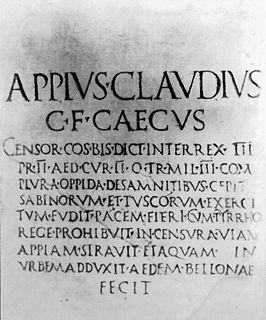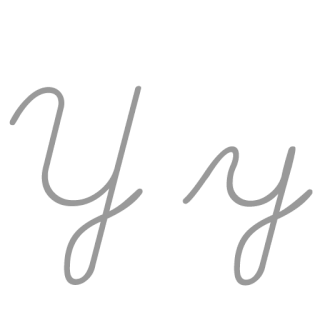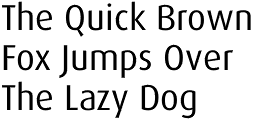
An alphabet is a standard set of letters that represent the phonemes of any spoken language it is used to write. This is in contrast to other types of writing systems, such as syllabaries and logographic systems.

Latin spelling, or Latin orthography, is the spelling of Latin words written in the scripts of all historical phases of Latin from Old Latin to the present. All scripts use the same alphabet, but conventional spellings may vary from phase to phase. The Roman alphabet, or Latin alphabet, was adapted from the Old Italic script to represent the phonemes of the Latin language. The Old Italic script had in turn been borrowed from the Greek alphabet, itself adapted from the Phoenician alphabet. The Latin alphabet most resembles the Greek alphabet around 540 BC, as it appears on the black-figure pottery of the time.
An orthography is a set of conventions for writing a language. It includes norms of spelling, hyphenation, capitalization, word breaks, emphasis, and punctuation.

Y is the 25th and penultimate letter in the modern English alphabet and the ISO basic Latin alphabet. In the English writing system, it sometimes represents a vowel and sometimes a consonant.
A spelling reform is a deliberate, often officially sanctioned or mandated change to spelling rules of a language. Proposals for such reform are fairly common, and over the years many languages have undergone such reforms. Recent high-profile examples are the German orthography reform of 1996 and the on-off Portuguese spelling reform of 1990, which is still being ratified by the different countries.
In linguistics, a phonemic orthography is an orthography in which the graphemes correspond to the phonemes of the language. Languages rarely have perfectly phonemic orthographies; a high degree of grapheme-phoneme correspondence can be expected in orthographies based on alphabetic writing systems, but they differ in how complete this correspondence is. English orthography, for example, is alphabetic but highly nonphonemic; it was once mostly phonemic during the Middle English stage, when the modern spellings originated, but spoken English changed rapidly while the orthography was much more stable, resulting in the modern nonphonemic situation. However, because of their relatively recent modernizations when compared to English, the Italian, Turkish, Spanish, Finnish, Czech, Latvian and Polish orthographic systems come much closer to being consistent phonemic representations.

The modern English alphabet is a Latin alphabet consisting of 26 letters, each having an upper- and lower-case form. The same letters constitute the ISO basic Latin alphabet. The alphabet's current form originated in about the 7th century from the Latin script. Since then, various letters have been added, or removed, to give the current Modern English alphabet of 26 letters:
The Greek alphabet has been used to write the Greek language since the late ninth or early eighth century BC. It is derived from the earlier Phoenician alphabet, and was the first alphabetic script to have distinct letters for vowels as well as consonants. In Archaic and early Classical times, the Greek alphabet existed in many different local variants, but, by the end of the fourth century BC, the Eucleidean alphabet, with twenty-four letters, ordered from alpha to omega, had become standard and it is this version that is still used to write Greek today. These twenty-four letters are: Α α, Β β, Γ γ, Δ δ, Ε ε, Ζ ζ, Η η, Θ θ, Ι ι, Κ κ, Λ λ, Μ μ, Ν ν, Ξ ξ, Ο ο, Π π, Ρ ρ, Σ σ/ς, Τ τ, Υ υ, Φ φ, Χ χ, Ψ ψ, and Ω ω.
In linguistics, vowel length is the perceived duration of a vowel sound. Often the chroneme, or the "longness", acts like a consonant, and may have arisen from one etymologically, such as in Australian English. While not distinctive in most other dialects of English, vowel length is an important phonemic factor in many other languages, for instance in Arabic, Finnish, Fijian, Kannada, Japanese, Old English, Scottish Gaelic and Vietnamese. It plays a phonetic role in the majority of dialects of British English and is said to be phonemic in a few other dialects, such as Australian English, South African English and New Zealand English. It also plays a lesser phonetic role in Cantonese, unlike other varieties of Chinese.
The Ukrainian alphabet is the set of letters used to write Ukrainian, the official language of Ukraine. It is one of the national variations of the Cyrillic script. The modern Ukrainian alphabet consists of 33 letters.
In an alphabetic writing system, a silent letter is a letter that, in a particular word, is not written out but spoken. sound in the word's pronunciation. In linguistics, a silent letter is often symbolised with a null sign U+2205∅EMPTY SET. Null is an unpronounced or unwritten segment. The symbol resembles the Scandinavian letter Ø and other symbols.
Dutch orthography uses the Latin alphabet and has evolved to suit the needs of the Dutch language. The spelling system is issued by government decree and is compulsory for all government documentation and educational establishments.
French orthography encompasses the spelling and punctuation of the French language. It is based on a combination of phonemic and historical principles. The spelling of words is largely based on the pronunciation of Old French c. 1100–1200 CE and has stayed more or less the same since then, despite enormous changes to the pronunciation of the language in the intervening years. This has resulted in a complicated relationship between spelling and sound, especially for vowels, a multitude of silent letters, and a large number of homophones. Later attempts to respell some words in accordance with their Latin etymologies further increased the number of silent letters. Nevertheless, there are rules governing French orthography which allow for a reasonable degree of accuracy when pronouncing French words from their written forms. The reverse operation, producing written forms from a pronunciation, is much more ambiguous.
A defective script is a writing system that does not represent all the phonemic distinctions of a language. For example, Italian has seven vowels, but the Italian alphabet has only five vowel letters to represent them; in general, the difference between close and open is simply ignored, though stress marks, if used, may distinguish them. Among the consonants, both and are written ⟨s⟩, and both and are written ⟨z⟩, though not many words are distinguished by the latter. Stress and hiatus are not reliably distinguished.
Th is a digraph in the Latin script. It was originally introduced into Latin to transliterate Greek loan words. In modern languages that use the Latin alphabet, it represents a number of different sounds. It is the most common digraph in order of frequency in the English language.
Ancient Greek phonology is the description of the reconstructed phonology or pronunciation of Ancient Greek. This article mostly deals with the pronunciation of the standard Attic dialect of the fifth century BC, used by Plato and other Classical Greek writers, and touches on other dialects spoken at the same time or earlier. The pronunciation of Ancient Greek is not known from direct observation, but determined from other types of evidence. Some details regarding the pronunciation of Attic Greek and other Ancient Greek dialects are unknown, but it is generally agreed that Attic Greek had certain features not present in English or Modern Greek, such as a three-way distinction between voiced, voiceless, and aspirated stops ; a distinction between single and double consonants and short and long vowels in most positions in a word; and a word accent that involved pitch.

A letter is a grapheme in an alphabetic system of writing. It is a visual representation of the smallest unit of spoken sound. Letters broadly correspond to phonemes in the spoken form of the language, although there is rarely a consistent, exact correspondence between letters and phonemes.








